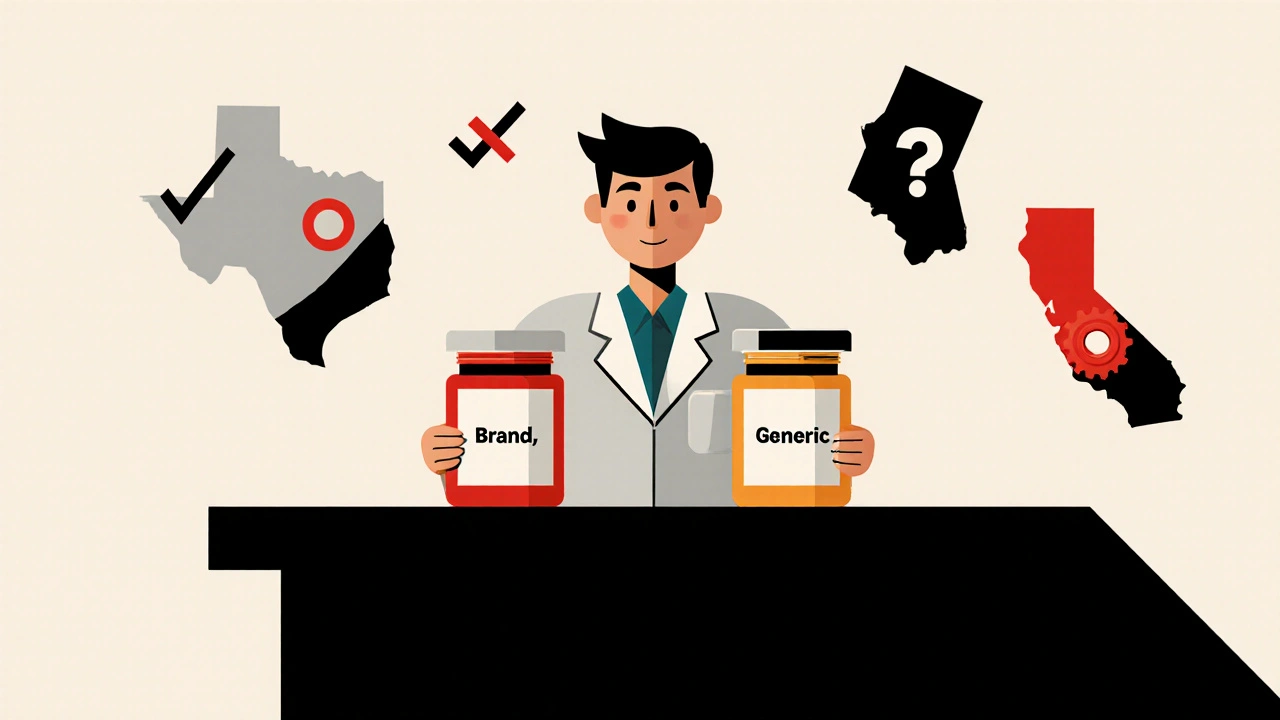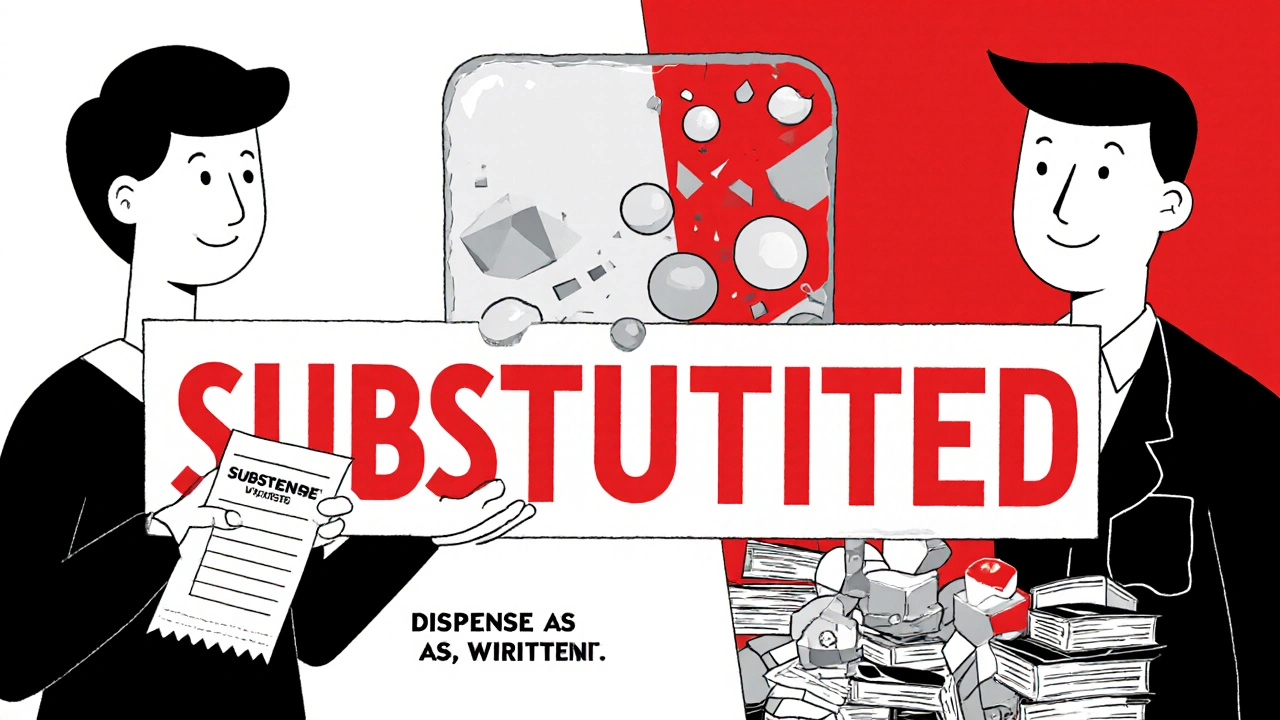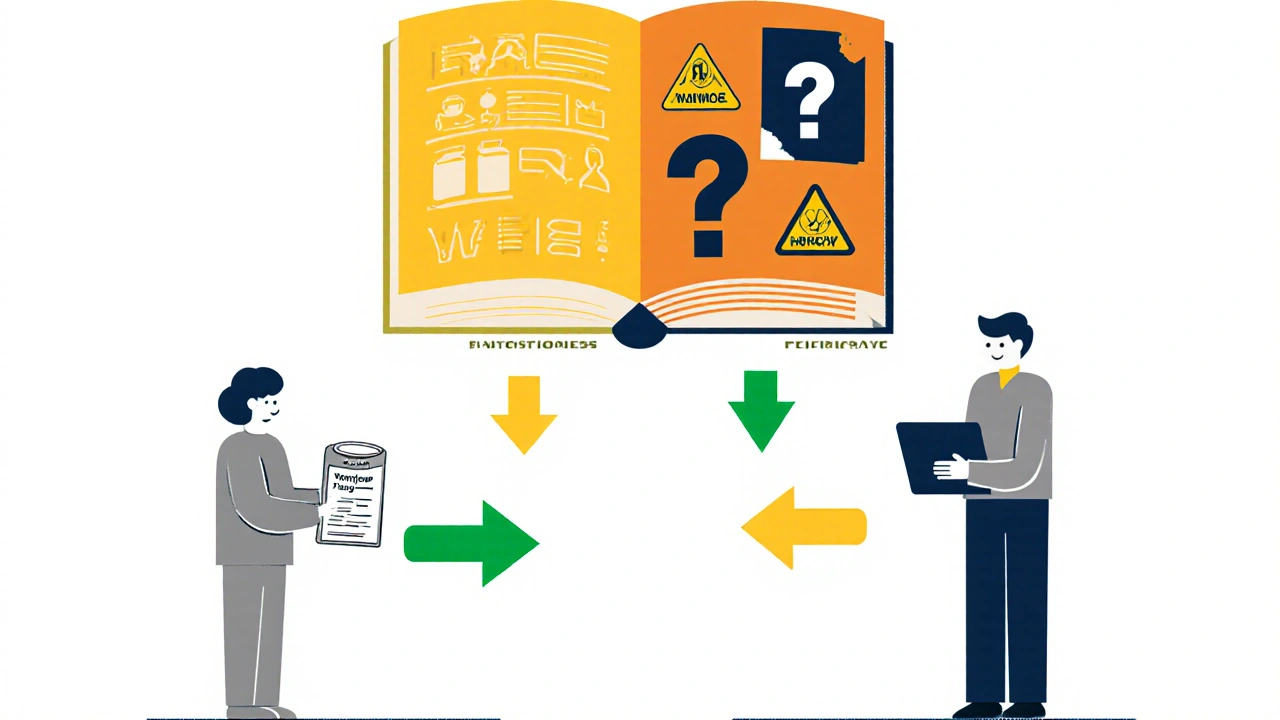State Laws on Generic Drug Substitution: What Pharmacists and Patients Need to Know
 Nov, 17 2025
Nov, 17 2025
Every year, Americans fill over 6 billion prescriptions. Nearly 93% of them are for generic drugs. That’s no accident. It’s the result of state laws designed to cut costs while keeping patients safe. But here’s the catch: generic substitution rules aren’t the same from one state to the next. What’s automatic in Texas is illegal in Hawaii. What’s required in Ohio is optional in California. For pharmacists, it’s a daily puzzle. For patients, it’s confusing-and sometimes risky.
Why State Laws Exist
The federal government cleared the path for generics back in 1984 with the Hatch-Waxman Act. It created a fast-track approval process so drugmakers could sell cheaper versions of brand-name drugs once patents expired. The FDA then started rating these generics in the Orange Book: if a generic was labeled "A," it was considered therapeutically equivalent to the brand. Simple, right? But states didn’t just accept that. They stepped in because they saw two things: massive savings and potential danger. Generic drugs saved the U.S. healthcare system over $1.7 trillion between 2009 and 2019. That’s real money. But for drugs like warfarin, levothyroxine, or epilepsy meds-even tiny differences in how the body absorbs the drug can cause serious harm. That’s why 15 states have their own lists of "narrow therapeutic index" (NTI) drugs that can’t be swapped without extra steps.How States Differ: The Four Big Rules
There are four main ways state laws control what pharmacists can do. And the differences matter more than you think.- Must they substitute? In 22 states, pharmacists are legally required to swap a brand drug for a generic unless the doctor says "do not substitute" or the patient says no. In the other 28 states, they can substitute-but they don’t have to. That means a prescription filled in Arizona might get a generic automatically, but the same script in Pennsylvania might come back as the brand name unless you ask for the cheaper version.
- Do they need your permission? In 32 states, the law assumes you’re okay with substitution unless you say otherwise. That’s called presumed consent. In 18 states, the pharmacist must ask you outright and get your yes before switching. One patient in New York told me she was shocked when her pharmacy switched her levothyroxine without asking-she didn’t know she had to speak up. In New Jersey, she’d have been asked.
- Do they have to tell you? Forty-one states require pharmacists to notify patients after a substitution. That could be a printed notice, a verbal warning, or a note on the receipt. But in nine states? No notice required. That means you might never know you got a different pill.
- Are they protected from lawsuits? Thirty-seven states shield pharmacists from legal trouble if they follow the rules. If a patient has a bad reaction after a legal substitution, the pharmacist usually can’t be sued. But in states without that protection, pharmacists may avoid substitution out of fear-even when the law allows it.
Biosimilars Are Changing the Game
Newer drugs called biosimilars-copies of complex biologic drugs like Humira or Enbrel-are now entering the market. These aren’t like simple pills. They’re made from living cells, and tiny differences can matter more. As of 2023, 49 states and D.C. have passed laws for biosimilar substitution. But the rules vary wildly. In Florida, pharmacies must create a formulary that says which biosimilars they’ll use, based on safety. In Iowa, they’re told to stick with the FDA’s Orange Book. Hawaii is the strictest: even for biosimilars, you need both your doctor’s okay and your own written consent if you’re taking an antiepileptic drug. That’s because seizures can be triggered by even minor changes in drug levels.
Who Wins and Who Loses?
The data shows clear patterns. States with mandatory substitution and presumed consent have higher generic use-up to 12% more than states with permissive rules. Medicaid programs in those states save about $1.2 billion a year. Patients in Texas and Illinois see fewer abandoned prescriptions because the cheaper option is automatically available. But it’s not all savings. Between 2020 and 2022, the FDA received 217 reports from patients who felt worse after a generic switch. Most involved levothyroxine (for thyroid) or warfarin (a blood thinner). One Minnesota patient had a stroke after switching to a different warfarin brand-even though both were rated "A" by the FDA. The dose was the same, but the way the body absorbed it changed just enough to cause a clot. Patients with rare diseases are especially worried. The Life Raft Group found that 41% of people with rare conditions fear substitution. Many have doctor notes that say "dispense as written"-and pharmacists in some states are still required to ignore those notes unless the patient objects.What Pharmacists Deal With Daily
Pharmacists aren’t just filling scripts. They’re legal compliance officers. On average, they spend 12.7 minutes per prescription checking state rules, FDA ratings, NTI lists, and patient history. That’s time they could spend counseling patients. Cross-state prescriptions are a nightmare. A patient living near the Ohio-Pennsylvania border might get their prescription filled in one state one week and the other the next. One week, they get a generic automatically. The next, they’re asked if they want it. Patients get confused. Pharmacists get frustrated. A 2022 survey found 78% of pharmacists feel overwhelmed by the patchwork of rules. Chain pharmacies now use software that auto-checks state laws, cutting errors by 64%. But small, independent pharmacies? Many still rely on printed state law handbooks and memory.
What You Should Do
If you take a drug for thyroid, epilepsy, heart rhythm, or blood thinning-generic substitution could affect you more than you realize.- Ask your pharmacist: "Is this the same as what I got last time?" Don’t assume.
- Check your receipt. If it says "substituted," you were switched.
- If you feel different after a switch-fatigue, dizziness, new symptoms-call your doctor immediately. It might be the generic.
- Ask your doctor to write "dispense as written" or "no substitution" on your prescription if you’ve had problems before.
- Know your state’s rules. A quick Google search for "[your state] generic substitution law" will bring up the pharmacy board’s page.
The Future: Standardization or Chaos?
The system is unsustainable. A 2023 draft from the Uniform Law Commission tried to create one national model for biosimilar substitution. It failed. States aren’t giving up control. Congressional Budget Office estimates say if all states aligned their rules, we could save $8.7 billion more by 2028. But patient advocacy groups warn that forcing uniformity could hurt people who need stability-especially those with rare diseases. Right now, the system is a mix of savings and risk. Some states prioritize cost. Others prioritize caution. The truth? There’s no perfect answer. But you have power: know your meds, ask questions, and don’t let a pharmacy switch your drug without you knowing.Can my pharmacist switch my brand-name drug to a generic without telling me?
In 32 states, yes-they can switch it automatically unless you say no. That’s called presumed consent. In 18 states, they must ask you first. Always check your receipt or ask your pharmacist if you’re unsure. If you take a drug like warfarin or levothyroxine, always confirm you got the same version as last time.
Are generic drugs really the same as brand names?
For most drugs, yes. The FDA requires generics to have the same active ingredient, strength, and effect as the brand. But for narrow therapeutic index (NTI) drugs-like blood thinners, thyroid meds, and seizure drugs-even small differences in absorption can matter. The FDA says they’re equivalent. Real patients sometimes report feeling different after switching. If you notice new symptoms, talk to your doctor.
Why do some states ban substitution for certain drugs?
Because for some drugs, tiny changes in how the body absorbs the medicine can lead to serious side effects. For example, switching between different versions of levothyroxine can cause thyroid levels to swing too high or too low. Kentucky, Minnesota, and other states keep lists of these high-risk drugs and block automatic substitution. These are called NTI drugs, and they need extra care.
What’s the difference between a generic and a biosimilar?
Generics are exact chemical copies of simple pills. Biosimilars are copies of complex biologic drugs made from living cells-like Humira or insulin. They’re not identical, just very similar. Because of this, states have stricter rules for biosimilars. Some require doctor approval, patient consent, or pharmacy formularies before switching.
Can I refuse a generic substitution even if my state allows it?
Yes. Every state allows patients to refuse substitution. If you’ve had bad reactions in the past, or your doctor recommends sticking with the brand, you can say no. Ask your pharmacist to call your doctor for a "dispense as written" note. You have the right to the exact medication your doctor prescribed.

Sameer Tawde
November 18, 2025 AT 06:03Love how this breaks down the real-world impact. I’ve seen patients panic when their meds change-especially with thyroid or blood thinners. A quick chat at the counter can save a hospital trip. Pharmacists are unsung heroes here.
Jeff Hakojarvi
November 19, 2025 AT 19:13soooo many people dont even know they got switched. i had a friend who thought her anxiety was getting worse-turns out the generic levothyroxine was making her jittery. she never even checked the label. this needs more awareness. 🙏
Timothy Uchechukwu
November 20, 2025 AT 06:04Ancel Fortuin
November 20, 2025 AT 07:11And yet the FDA says they’re equivalent. Funny how the same people who trust the FDA for safety suddenly don’t trust them when it comes to generics. Coincidence? Or is Big Pharma just whispering in statehouses again?
Ronald Stenger
November 20, 2025 AT 08:08Let’s be real-this isn’t about patient safety. It’s about state budgets and pharmacy chain profits. Mandatory substitution? That’s cost-shifting disguised as policy. And don’t get me started on the 9 states that don’t even notify patients. That’s not negligence-it’s malfeasance.
Samkelo Bodwana
November 21, 2025 AT 11:34I’ve lived in three states and seen this play out differently every time. In South Africa, generics are just… generics. No fuss, no forms, no consent. But here? It’s like we’re playing legal roulette every time we fill a script. I get the concern for NTI drugs, but why not just make the rules clearer across the board? Why does every state think they know better than the next?
Emily Entwistle
November 21, 2025 AT 21:07OMG YES 😭 I switched to a generic warfarin last year and felt like a zombie for a week. My doctor didn’t even know it happened. Now I always check the bottle AND ask. Also, if you’re on anything NTI-WRITE "DO NOT SUBSTITUTE" in giant letters on your prescription. 📝💊 #StayVigilant
Duncan Prowel
November 22, 2025 AT 10:30It is worth noting that the divergence in regulatory frameworks across jurisdictions introduces significant administrative burden upon healthcare professionals, particularly those engaged in inter-state practice. The absence of harmonisation undermines both clinical efficacy and patient autonomy. A unified national standard, while politically contentious, would demonstrably enhance system efficiency and safety.
Bruce Bain
November 23, 2025 AT 01:23My grandma takes levothyroxine. She didn’t know she got switched until I checked the bottle. Now I check every time. Simple rule: if it looks different, ask. No shame in asking. Better safe than sorry.
Jonathan Gabriel
November 24, 2025 AT 08:42Here’s the real irony: we trust a pill made in a factory in India to be identical to one made in New Jersey… but if it’s 0.05% less absorbed? Suddenly it’s a medical emergency. The FDA’s "A" rating is a statistical average-not a guarantee for your body. We’re treating biology like software updates. It doesn’t work that way.
benedict nwokedi
November 24, 2025 AT 10:39Of course the states won’t unify-because the FDA is just a puppet of Big Pharma. They want you dependent on expensive brand-name drugs. The "NTI" excuse? A distraction. Look at the corporate lobbying behind state laws. This isn’t safety-it’s profit.
deepak kumar
November 26, 2025 AT 09:11From India: we don’t have this problem. Generics are the norm, and pharmacists just give you what’s in stock. But we also don’t have the same level of patient education. Maybe we’re lucky-or maybe we’re just blind. Either way, your system is way too complicated. Simplicity saves lives.
Dave Pritchard
November 26, 2025 AT 10:54For anyone reading this-don’t be shy to ask your pharmacist to call your doctor for a "dispense as written" note. It’s your right. And if you’ve had a bad reaction before? Keep a note in your phone or wallet. It’s a small step that could save your health.
kim pu
November 27, 2025 AT 16:18so like… the FDA says it’s fine but my body’s like "nah fam"?? i call it the "generic ghosting"-your meds switch and your body’s like "wait who are you??" 🤪 i switched to a new levothyroxine and started having panic attacks. no one told me. i thought i was going crazy. turn out the pill was the same but the filler was different. like, what even is medicine anymore??
malik recoba
November 28, 2025 AT 23:59My dad’s on warfarin. He doesn’t even know what a generic is. I had to sit him down and explain how to check the bottle. He’s 72. He shouldn’t have to be a pharmacist too. This system is broken. We need better labels, better training, and better communication. No one should feel scared to take their medicine.